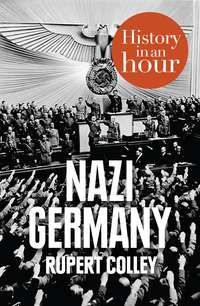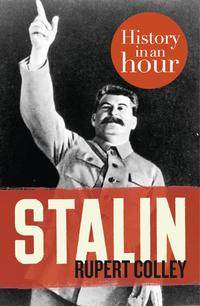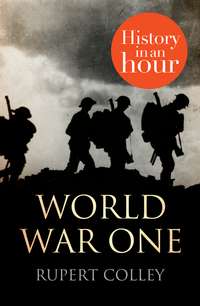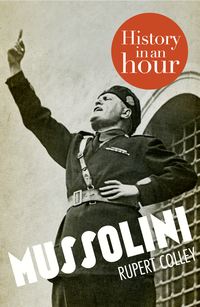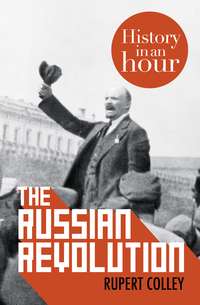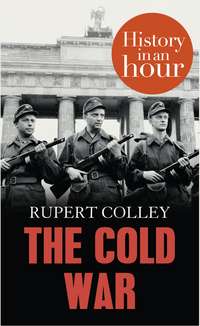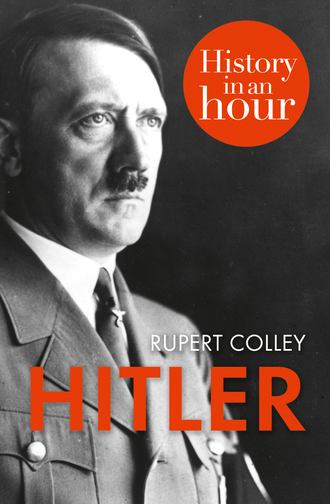
Полная версия
Hitler: History in an Hour

HITLER
History in an Hour
Rupert Colley

About History in an Hour
History in an Hour is a series of ebooks to help the reader learn the basic facts of a given subject area. Everything you need to know is presented in a straightforward narrative and in chronological order. No embedded links to divert your attention, nor a daunting book of 600 pages with a 35-page introduction. Just straight in, to the point, sixty minutes, done. Then, having absorbed the basics, you may feel inspired to explore further.
Give yourself sixty minutes and see what you can learn . . .
To find out more visit: http://historyinanhour.com or follow us on twitter: http://twitter.com/historyinanhour
Contents
Cover
Title Page
About History in an Hour
Introduction
Hitler the Boy
Hitler the Youth
Hitler the Dropout
Hitler the Soldier
Hitler the Agitator
Hitler the Revolutionary
Hitler the Martyr
Hitler the Politician
Hitler the Leader
Hitler the Diplomat
Hitler the Warlord
Hitler the Man
Hitler’s Women
Hitler’s Health
Hitler the Anti-Semite
Hitler the End
Appendix 1: Key Players
Appendix 2: Timeline of Hitler
Copyright
Got Another Hour?
About the Publisher
Introduction
What made a failed Austrian artist into the most reviled and destructive personality of the twentieth century? Where did the seeds of his rabid anti-Semitism lie? How did a marginalized loner become such a moving force in Germany? How could a nation have fallen for such a maverick? What made him so determined to bring about war?
This, in an hour, is the story of Adolf Hitler.
Hitler the Boy
Klara Hitler’s life was blighted with tragedy. Her first three children had all died as infants, and when she fell pregnant for a fourth time, the omens were not good. However, this child, born Easter Saturday, 20 April 1889, although sickly, survived. She named him Adolf.
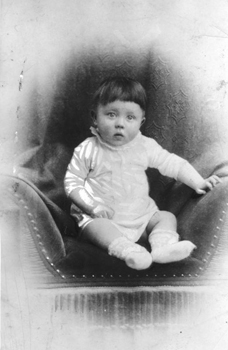
Hitler as a baby, c.1889
Adolf Hitler was born in the village of Braunau am Inn, on the Austrian-German border, which Hitler, in the very first sentence of Mein Kampf, deemed ‘providential’ as he was to unite the two countries.
The Hitler family moved several times, always depending on his father Alois’ job. Alois’ final posting was to a village on the outskirts of Linz where he retired and spent his final years. Adolf, who was five, was to retain a lifelong affection for Linz, which he always regarded as his home town.
Another boy, Edmund, was born in 1894 but lived for less than six years – a devastating blow for the eleven-year-old Hitler. In January 1896 came a daughter, Paula, who survived and lived into adulthood. Klara had had six children but only two survived beyond infancy. But as well as her own two children, Klara looked after her two stepchildren, both from Alois’ second marriage. Alois, now in his final years, had no time for his children and preferred to wile away his time in the local tavern or looking after his bees. Often drunk, he repeatedly beat Adolf. Klara, who for many years still called her husband ‘Uncle’, smothered her son but was unable to prevent the thrashings.
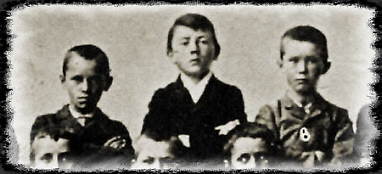
Hitler as a schoolboy
Young Hitler (pictured above in the centre) did well at primary school but, following the death of his younger brother, less so at secondary where he was frequently criticized for his laziness and arrogance. But he was good at art and harboured ambitions to become an artist, a prospect that alarmed his father who wanted his son to follow him into the customs service. Hitler had no intention of holding down a dreary day job as his father had done all his working life and informed Alois of his artistic ambitions. According to Mein Kampf, Hitler Senior reacted with the words, ‘Artist? No, never as long as I live.’
But, on 3 January 1903, while enjoying his early morning glass of wine at the tavern, Alois collapsed and died. Cause of death was either a heart attack or stroke. He was sixty-five; his son thirteen.
Hitler the Youth
Hitler, never enamoured with school, left at sixteen. His mother was disappointed but Adolf had inherited his father’s obstinacy and Klara was too soft to assert her authority. Hitler looked back on his years of education with an ‘elemental loathing’. Alois had left his family comparatively well off and Hitler, free of his father’s bullying and expectations, devoted his efforts to leading a life of idleness. Living in a flat in the centre of Linz, Hitler indulged in his painting by day and his love of the theatre and opera by night. Closeted from the real world by his mother, finding work was never high on Hitler’s agenda.
In Linz Hitler made friends with a young man called August Kubizek, or ‘Gustl’. They became friends through their shared love of the operas of Richard Wagner, and while Hitler dreamt of becoming a great artist, Kubizek dreamt of becoming a conductor. In the evenings they would dress up and enjoy the opera or the theatre, but during the day, while Kubizek worked at his father’s upholstery workshop, Hitler lounged around, daydreaming. Kubizek was the compliant one of the two – while Hitler voiced his opinion on everything, whether good or bad, and sometimes with unnerving passion, Kubizek quietly listened.
Kubizek noted how Hitler fell in love with a girl called Stefanie, but despite his overbearing arrogance in all other matters, he was too painfully self-conscious to try to strike up a conversation with the subject of his affections.
In early 1906, aged sixteen, Hitler visited Vienna for the first time. Staying only two weeks he returned to Linz which now seemed small and provincial in comparison. Hitler decided to apply for a place at Vienna’s Academy of Fine Arts and, in September 1907, despite his mother’s reluctance and aided by a generous loan from his aunt Johanna, he moved to Vienna. Despite passing the initial exams, the would-be artist failed to secure a place. Of the 113 applicants only 28 passed so there was no shame involved but Hitler saw it as a failure and it struck him like a ‘bolt from the skies’. His examiners encouraged Hitler to concentrate on architecture instead.
Before Hitler left for Vienna, he and his sister, Paula, had learnt of their mother’s breast cancer. Towards the end of 1907, Hitler received word that his mother was dying. He rushed back to Linz and nursed her, devotedly, through her final days. She died on 21 December 1907, aged only forty-seven. According to his mother’s Jewish doctor, Edward Bloch, Hitler was with her as she died. ‘I have never seen anyone’, wrote Dr Bloch later, ‘so prostrate with grief as Adolf Hitler.’ Later, Hitler presented the good doctor with one of his paintings. In Mein Kampf Hitler wrote of his parents: ‘I had honoured my father but loved my mother.’ Hitler worshipped his mother and she was perhaps the only person he ever loved. Following her death, Hitler’s contact with his family rapidly dwindled.
Hitler returned to Vienna in February 1908, but found that he was missing his only friend, Kubizek. He wrote to Kubizek’s father to ask him allow his son to join him in the city, from where he could pursue his ambition to become a conductor. Kubizek Senior, who hoped that his son would follow him into the upholstery trade, reluctantly gave in. On 22 February, August Kubizek arrived in Vienna to be reunited with his friend.
Kubizek applied for a place at the University of Music and Performing Arts, Vienna and was immediately successful. Kubizek assumed his friend had already started his studies at the Academy of Fine Arts – Hitler had not told anyone of his failure to gain a place. Eventually the truth came out and Hitler, beside himself with rage on telling of his lack of success, blamed everyone but himself.
While Kubizek studied, Hitler slept, daydreamt and came up with grandiose plans that came to nothing. In a fit of enthusiasm he began writing the libretto for an opera along Wagnerian lines, but the enthusiasm soon petered out. In October 1908, Hitler applied again for a place at the Academy of Fine Arts and again failed, this time at the initial stage. Again, he kept his failure to himself.
On finishing his first term, Kubizek returned home briefly to Linz. When he came back to Vienna in November 1908 Hitler had moved out. He had left no forwarding address. Kubizek would not see his friend again for another thirty years.
Hitler the Dropout
Suffering bouts of depression and with his aunt’s money running out, Hitler moved from one impoverished accommodation to another and spent his last three years in Vienna in a men’s hostel. For a while he struck up a deal with a fellow guest, Reinhold Hanisch; while Hitler painted Viennese street scenes, Hanisch sold them and the two would split the profit. But while Hanisch managed to sell, Hitler’s commitment to painting a picture a day faded and the agreement ended acrimoniously.
Despite having lived in Vienna for six years, Hitler had made few friends, certainly none that he talked about. Acquaintances and ex-room-mates at the hostel remembered him not simply for his anti-Semitism, which was commonplace in Vienna at the turn of the century, but for the extent of his fanaticism against Jews, religion, priests, the Habsburg monarchy, the aristocracy, the middle classes and a number of other pet hates. He preached, with alarming fervour, the cause of a pan-Germany, the unification of all German-speaking people as one state. He would frequent cafés and sermonize to whoever was unfortunate enough to be caught within his orbit. He showed no interest in women, believing that men should remain celibate until the age of twenty-five.
Hitler decided to move to Germany, but had to wait in Vienna until he received his father’s small inheritance, which was due on his twenty-fourth birthday – 20 April 1913. Once secured, he was able to leave Vienna and, in May 1913, start afresh in a ‘true German city’, the city of Munich, the capital of Bavaria, an independent federal state within Germany with its own king, King Ludwig. But Hitler’s move to Bavaria was also motivated by the desire to avoid conscription into the Habsburg army. Hitler was not a draft dodger but he despised the Habsburg monarchy so much he had no wish to serve in its army.
His life in Munich differed little from that in Vienna – lacking work, money and friends, living in hovels and wandering aimlessly around the city, admiring the architecture and striking up one-sided conversations in cafés. But Hitler looked back on his time in Munich with fondness, calling it ‘by far the happiest time of my life’. In February 1914, the Habsburg army caught up with him; put him in front of a military tribunal in Salzburg, only to declare him unfit for service.
Hitler the Soldier
Six months later, on 1 August 1914, Germany declared war on Russia. The news was received enthusiastically throughout the country and Hitler, especially, was ecstatic.
A photograph taken on 2 August outside the Feldherrenhalle (the Field Marshals’ Hall) in Munich shows a large, unruly crowd of happy Germans cheering the news. Amongst them, his face rapt with joy, was the 25-year-old Adolf Hitler.
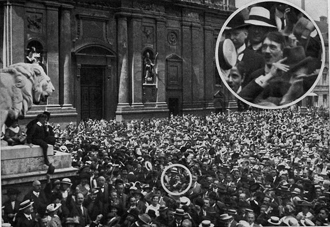
News of the outbreak of war is received enthusiastically in Munich, August 1914. Among the crowd is Hitler
Hitler tried to enlist immediately, but as an Austrian was rejected. A letter to King Ludwig swearing his devotion to the German cause did the trick though, and Hitler was allowed to join the 16th Bavarian Reserve Regiment, known as the List Regiment after its commander, Colonel List.
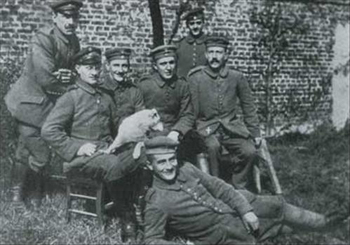
Hitler as a soldier, c.1914
The List Regiment fought and suffered terribly on the Western Front during the First Battle of Ypres. Hitler (pictured above, seated far right) was awarded the Iron Cross (Second Class) and promoted to the rank of lance corporal for saving a wounded officer stranded in noman’s-land. ‘It was,’ he wrote to his Munich landlord, ‘the happiest day of my life.’ Hitler’s task, as a dispatch runner, was to carry messages to and from the headquarters behind the front to the officers in the field, often under artillery fire. Having been promoted to corporal so early on in the war, the expectation would have been promotion to sergeant but his superiors denied him, believing Hitler would never command the respect of his men.
Hitler was not a typical soldier. He did not drink, smoke or seek the company of the local prostitutes, and actively voiced his disgust of these common pursuits. Although respected by his comrades, he seemed uninterested in forming friendships and preferred his own company, reading, sketching, painting watercolours, writing poetry and contemplating. (Hitler’s skill as an artist, although far from the genius he sometimes believed he was, was credible, but his poetry left much to be desired.) He received no parcels, nor letters, and when he did talk it was invariably to lecture on one of his pet subjects. His only companion was a white terrier dog he befriended and named Foxl. He was distraught when, on separate occasions, Foxl and his sketchbook were stolen. But the war gave Hitler’s life a purpose. The listless, daydreaming wanderer who had never done a day’s work had found his vocation.
In October 1916, the List Regiment joined the fray at the Battle of the Somme. Again, the regiment was decimated and Hitler, who had managed to survive unscathed for so long, had become almost a talisman for his comrades. But Hitler’s luck was about to run out and on 7 October a piece of shrapnel lodged in his left thigh – or, as later rumoured, his groin, and it was from this incident that the joke that Hitler lacked a testicle came. Despite his protestations that he was fit enough to carry on, Hitler was invalided back to Germany and to Berlin.
It was the future leader’s first visit to the capital. While impressed by the city and its architecture and history, Hitler became increasingly angered by the defeatist talk of its impoverished and hungry civilians. He said he saw Jews everywhere, equating them to spiders sucking the blood from people, and the streets were full of workers on strike, whom he despised as cowards and traitors.
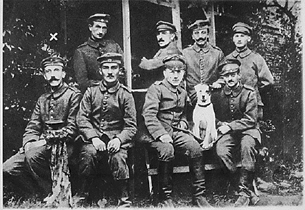
Hitler as a soldier, c.1917, Picture from the Office for Emergency Management, Office of War Information
In March 1917, much to his delight, Hitler was declared fit and returned to the front. Warmly welcomed by his comrades, Hitler (pictured above on the far left) returned to his duties as messenger. He disliked the new recruits who, unlike his optimistic generation, arrived at the front full of pessimism. The regiment fought at Arras and Passchendaele and in August 1918 Hitler was awarded another Iron Cross, this time First Class, a rarity for a non-commissioned officer. The recommendation came from one Hugo Gutmann, an officer in the List Regiment and a Jew.
Two months later, on 13 October 1918, the regiment suffered a gas attack and Hitler and many of his comrades were partly or temporarily blinded. For the second time Hitler was invalided back to Germany, this time to Pomerania. It was during his recuperation that Germany, who not long before had been on the offensive, surrendered and signed the armistice ending the war.
Hitler, still recuperating and fearing for his sight, was devastated.
After stints as a border guard and a prisoner-of-war guard, Hitler returned to Munich in February 1919, totally unsure what the future held for him, and fearing a return to civilian life, determined to remain in the army.
Hitler the Agitator
Germany and especially the state of Bavaria, was in a state of chaos in the immediate post-war years. In Berlin a communist coup failed but in Bavaria, on 6 April, a Soviet Republic took over. The 29-year-old Hitler was part of this Soviet Republic, a Bolshevik-inspired regime whose leaders were predominantly Jewish. Hitler was elected as a representative of his battalion to ensure that the army in Munich remained loyal to the Red Republic. In desperation, Germany’s chancellor, Friedrich Ebert, called in the Freikorps, a group of violent, far-right ex-soldiers, and the Soviet Republic in Bavaria was brought to a bloody end. Hitler laid low; he played no part in its demise. The Soviet Republic of Bavaria had barely lasted a month but Hitler failed to mention in Mein Kampf that for a few weeks at least he served for a communist-inspired, Jewish-led regime.
Following his flirtation with the far left, Hitler remained in the army and started to be groomed as a political instructor, to ensure that the soldiers had not been overly influenced by the communists. In August 1919, encouraged by his mentor, Captain Karl Mayr, he went on a training course and there discovered his talent for public speaking. His speeches were so well attended that he became a star turn. When Mayr was asked, by letter, by a fellow trainee, Adolf Gemlich, to clarify the position on the Jewish question, Mayr passed it on to Hitler for a response. Hitler wrote that Judaism was not a religion but a race and the ‘final goal’ had to be ‘the irrevocable removal of the Jews themselves.’ The ‘Gemlich letter’ is the first known written statement, at the age of thirty, of Hitler’s anti-Semitism. (Captain Mayr was later to renounce Hitler and died in a concentration camp in 1945).

Hitler c.1920
Hitler monitored political developments in Munich and reported back to his superiors. It was in this role that, on 12 September 1919, Hitler was sent to a meeting of the German Workers’ Party, or, to use its German abbreviation, DAP. Founded in January 1919 by a 35-year-old Munich locksmith, Anton Drexler, the DAP was typical of many far-right parties in Germany at the time. Small and inconsequential, its membership cards began at the number 500 to give the impression of larger numbers. When during Hitler’s visit, one of the DAP’s members made a speech in favour of Bavarian independence. Hitler, the great advocate of a pan-Germany, interrupted with an aggressive counter-argument. Drexler was impressed and invited Hitler back to another meeting. He did return and was soon to join DAP as member 555, not the seventh as he later claimed, and signing his name as Hittler. Drexler believed his party could use someone with the gift of Hitler’s gab.
In October 1919, Hitler delivered a beer hall speech to an audience of a hundred. Within four months he was attracting over 2,000 listeners with his histrionic, hate-fuelled speeches attacking the enemies of Germany and the scapegoats blamed for all her ills, the Jews, the communists, and the Weimar politicians.
Germany was still in a state of anarchic chaos. In June 1919, the newly formed Weimar government signed the Treaty of Versailles, the document drawn up in Paris by the victorious powers following the war. The treaty stripped Germany of her armed forces, demilitarized the Ruhr (lest France should feel threatened by a military presence on its border), and forced Germany to pay reparations as compensation. But it was the ‘war guilt’ clause that rankled most with the German population, forced to accept that Germany had been ultimately responsible for the war.
By meekly accepting the treaty, the Weimar government undermined its power from the outset. Extremism flourished amongst the chaos as supporters and thugs of extremist parties, left and right, fought pitched battles in the streets and in the beer halls.
Hitler revelled in the turmoil and offered something different – an unusual blend of nationalism and socialism. In February 1920, having sidelined Drexler, Hitler extended the name of the DAP to reflect its message – the National Socialist German Workers’ Party, or NSDAP. Its opponents, in an attempt at derision, soon abbreviated it further to Nazi. The newly named party drew up a programme of twenty-five points, its manifesto, which included attacks on the Treaty of Versailles, Jews, advocated a pan-Germany, and called for living space in the east, lebensraum: ‘to secure for the German people the land and soil to which they are entitled on this earth.’
In June 1921, Hitler faced his first challenge to his leadership when Drexler and members of the Nazi committee criticized his ‘lust for power and personal ambition’. Hitler offered to resign. He knew that without him the party was nothing. The conceited bluff worked and the committee confirmed Hitler as party chairman, and pensioned Drexler off as its ‘honorary president’.
Hitler the Revolutionary
The Nazi Party was attracting men who would stay at Hitler’s side for many years. Ernst Röhm, a violent, nationalist ex-soldier and ex-member of the Freikorps, was one of Hitler’s earliest accomplices, as was the once-dashing First World War fighter pilot, Hermann Göring, who introduced Hitler to the wealthier, more genteel classes. Hitler, always a hater of the aristocracy, pushed his prejudices to one side to play the perfect gentleman, sympathetic to their concerns, and winning much support and financial aid. But at the same time, Hitler maintained his appeal to the working classes as hyperinflation decimated savings overnight and rendered money worthless.
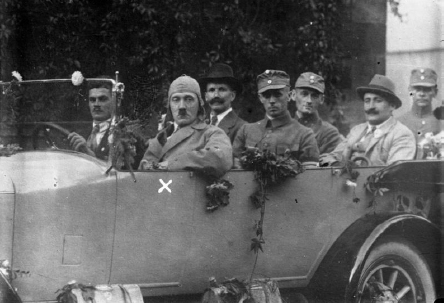
Hitler and his entourage c.1923
Bundesarchiv, Bild 102-00204 / CC-BY-SA [CC-BY-SA-3.0-de (www.creativecommons.org/licenses/by-sa/3.0/de/deed.en)]
Конец ознакомительного фрагмента.
Текст предоставлен ООО «ЛитРес».
Прочитайте эту книгу целиком, купив полную легальную версию на ЛитРес.
Безопасно оплатить книгу можно банковской картой Visa, MasterCard, Maestro, со счета мобильного телефона, с платежного терминала, в салоне МТС или Связной, через PayPal, WebMoney, Яндекс.Деньги, QIWI Кошелек, бонусными картами или другим удобным Вам способом.




